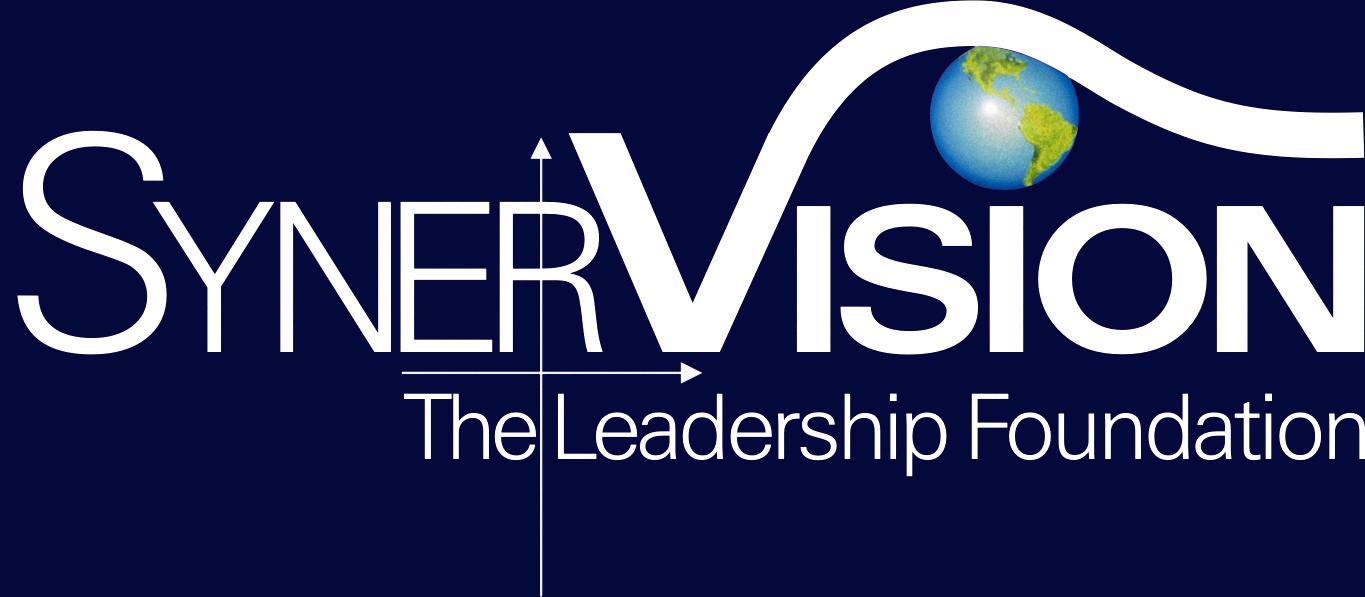

Not Making a Decision IS Making a Choice
Page 8 Doing Less Gets More Done Page 12 Future Forecasting: And Making It Happen
Page 18 Hugh’s Recipe of the Month Page 33




Not Making a Decision IS Making a Choice
Page 8 Doing Less Gets More Done Page 12 Future Forecasting: And Making It Happen
Page 18 Hugh’s Recipe of the Month Page 33

SynerVision Leadership Foundation provides a pathway of enlightened engagement for organizations seeking transformation. SVLF helps nonprofits seeking ways to serve well and respond to the tide of global change who feel lost and uncertain, battered and dispirited. These seekers look with dismay at the unproductive previous attempts they have made at organizational change and improvement. Consultants, seminars, and books have promised much to these searching communities and delivered little more than reworked methods from times now long past. Indeed, we are in a time when methods and manuals, quick fixes and weekend seminars do not provide lasting transformation.


Nonprofit Exchange Page 7

’ S I N S I

Courageous Leadership Say No With Style

Not Making a Decision IS Making a Choice

Asleep at the Wheel Drives You Off the Rails Doing Less Gets





September14th



So much has happened at SynerVision Leadership Foundation so far this past more than half a year, it’s hard to imagine what is in store for the remainder.
While it took quite a bit of deliberation, deep thought, hesitation, and finally a serious discussion about creating a Nonprofit Prosperity Counsel: Philanthropy Redefined project co-created with the C-Suite Network. The official launch of the Council occurred in June in Dallas, Texas. That location was chosen due to the opportunity to not only announce the newly formed activity among a large contingent of C-Suite Network Members, a full day was dedicated to a full-day Leadership Symposium to showcase Synervision’s capabilities. Needless to say, Hugh’s efforts were well received, and even more so, rewarded. In the history of the creation of C-Suite Network Councils, the CSNNPC was the most successful launch.
Thank all of you who are taking the opportunity to participate in the Council activities you are grandfathered into as a result of holding an Influencer Status (a paid membership in the SynerVision Community) and we hope you will take full advantage of what is available to you.
This month we celebrate a national holiday in the USA, a day to honor the work people perform. Labor Day has been celebrated since the late 1800's, and with all of the changes that have occurred in the working world, from the closing of coal mines, to the expansion ot technology with the introduction of Artificial Intelligence, there’s a lot to celebrate.
Labor Day in the US typically means the closing of the public swimming pools in many northern cities across the country. It also reflects “the end of summer BBQ events families look forward to.
I hope you had a great summer, and look forward to the cooler season ahead. I know I am, as it is still in the 90's where I reside.
DJD


“Without forgiveness, life is governed by an endless cycle of resentment and retaliation.”
-ROBERTO ASSAGIOLI
by Hugh Ballou

“Two roads diverged in a wood, and I –I took the one less traveled by, And that has made all the difference.”
― Robert Frost
Choices are very important in leadership. Making the wrong choice costs money and potentially damagestheorganization. Theburden isontheleadertomakeeffective and wisechoices.
Not making a decision is a choice. Sometimes, paralyzed by the gravity of the choice, leadersstallandcan’tdecide.Notmakingachoiceiscertainlyachoice.
What’stheimpactofthedecisionontheorganization?
What’stheimpactofthedecisiononrelationships?
What’s the impact of the decision on revenue…customer satisfaction…client engagement…stakeholderinvolvement…?
Askingthesequestionsbeforemakingadecisionhelpsleadersrecognizetheconsequences ofthedecision.
Maybeaskingthosequestionsbeforenotmakingachoicewouldbegood,aswell. Makingwise,informedchoicesisthedutyanddelightoftheleader.Makingpoorchoices cancostalotmoreand,certainly,waitingtomakeadecisionincreasesthecostorimpact oftheproblemtothecultureortotheprofitasthesituationgetsworse.
Themostdifficultofchoicestypicallycenteronpeopleissues,suchaswhentoterminate the employee, when to give a salary increase, when to correct their behavior, when to challengeanonparticipatingboardmember,etc.Eachofthesescenarioscausesleadersto shyawayfromconfrontingcontroversialissues.

by DJD

Ah, leadership. That grand escapade where you trade your regular chair for one that might swivel slightly more and makeyoufeellikeyou’reinchargeofthe universe. But let’s cut to the chase – the true test of courageous leadership isn’t slaying dragons or conquering empires. No, it’s about mastering the delicate art ofsaying"No"toBob’s37thproposalfor acompanypettingzoo.
Imagine this scenario: Your team, eyes gleaming with enthusiasm, bursts into your office with their latest "gamechanging" idea – installing napping pods that double as escape rooms. As the braveleader,it’syoursolemndutytonod sagely, maybe stroke your chin for dramatic effect, and then... shatter their hopes with a firm, yet considerate, "Nope."
Why, you ask? Because courageous leadership isn’t about earning popularity points. It’s about steering the ship away fromtheicebergwhichisTodd’s
suggestionforweeklytacotruckvisitsduring boardmeetings.Every"No"youdeliverwitha dash of grace and a sprinkle of humor is a triumphforpracticalityandcommonsense.
Next time someone pitches an idea that sounds like it was conjured up by a caffeinated squirrel on a sugar high, channel your inner superhero. Think of yourself as Captain No-way, a defender of logic and sanity.Yourteammightgroan,rolltheireyes, or even sigh heavily, but deep down, they’ll appreciate you for rescuing them from their imaginativechaos.
So, when Janet proposes turning the break roomintoaZengardencompletewithlivekoi fish and Gary suggests replacing all office chairs with yoga balls to "enhance core strength," remember your mission. Embrace yourroleasthegatekeeperofsanityandsay "No" with flair. Remind yourself that you’re notjustsquashingdreams–you’resavingthe office from descending into a whimsical wonderlandwhereproductivitygoestodie.

Leadership isn’t about making everyone happy. It’s about making decisions that keep the company from turning into an episode of a particularly wacky reality show. And whoknows?Maybebysaying"No"oftenenough,you’llfinallyhavetimetofocusonthe ideasthatdon’tinvolvepettingzoos,escaperooms,ortacotrucks.Or,attheveryleast, you’llhavesavedeveryonefromdressingupasvegetableseveryotherFriday.
Intheend,beingacourageousleaderisallaboutbalance.It’saboutknowingwhento letyourteam’screativityflourishandwhentogentlyredirecttheirenergiesawayfrom therealmoffantasy.So,putonyourmetaphoricalsuperherocape,strikeapose,and getreadytodeliverthatnext"No"withstyle,wit,andatouchofhumor Yourteam–andthefutureofyouroffice–willbeallthebetterforit.

Nonprofitsareoftendrivenbypassion,purpose,andthedesiretomakeameaningful impact. But when it comes to financial management, even the most mission-driven organizationscanfindthemselvesveeringoffcourse.Nonprofitmissionsaresupposed to be efficiently running down the track, but watch out. Without careful attention to cash flow, strategic decision-making, and a proactive approach to financial oversight, theverycausestheseorganizationschampioncanbejeopardized.
Cashflowforecastingisthelifebloodofanynonprofitorganization,yetit’softentreated as an afterthought. The reality is that effective leaders know their numbers every morning, not just once a month. Regular cash flow forecasting enables leaders to anticipate challenges before crises, ensuring that the organization has the liquidity neededtomeetitsobligations,pursueopportunities,andsustainitsmission.
Takealookathownonprofitleaderscanavoidbeing“asleepatthewheel”andkeep theirorganizationsontrack.

Save the Children International (SCI), a global humanitarian organization, found itself in a precarious financial position due to a projected budget shortfall of $15-$20 million.
continued on page 14
by Hugh Ballou

I constantly hear from leaders that they are doing too much. I respond by asking howtheycontributedtothesituation.The first response to that question is a puzzled look. It’s a revelation that we actuallycauseproblemsasleaders.Itisa very sobering fact that we set up problems.
Manyofthoseproblemsaresetupbythe leader’s over-activity – talking too much, over functioning, defining all the solutions, and telling others what to do. We have learned from others that these are things leaders do. We have been taughtthewrongthings.
I specialize in reverse paradigms. John Heider(quotedabove)talksaboutreverse polarities in his book. Here are some reversestrategiestoconsider:
Talklessandlistenmore–Over-talking is easy to do. After all, the leader owns the vision and knows more than anyone else,right?Wrong!Oncealeadersaidto
me that they were always right. I responded, suggesting that it was more important that the members of the team beright.Toomuchtalkingisasignthatthe leader is anxious and blocks input from others who might have the right ideas. Observing and listening are primary leadership skills. Doing less and getting more done is empowered by not talking, andlisteningmore.
Ask good questions and listen to the answers–Manyleadersperceivethatthey must have all the answers. I disagree. Leaders must ask good questions. That’s the first part. The second part is to listen carefully to the answers. It’s amazing what youcanlearnbylisteningifyoutakeaway the need to be right and the need to respond to those answers. Listen. Leave somesilence.Thenrespond,ifappropriate. Doing less and getting more done is empowered with good questions and intentionallistening.
Observeandrespond–Leaderslistento the words of others. Watching how people respond is very informative. Research tells us that only 7% of communication is in words. Observe what’s happening and observe how things happen. The musical conductor guides the music-making and does not make the music. Reacting is a negative energy. Responding comes with discernment. Watch, think, listen, and then respond. Many times a response is not necessary. Having good people and getting out of their way is a good leadership skill. Doing less and getting more done mostly happens when the leaderobserves.
Function less and empower others to function more – Overfunctioning is a leadership disease. More leaders have it than not. The reciprocity to overfunctioning is under-functioning. The musical conductor draws out the music from the ensemble. Leaders let others function.Doingthingsforothers,making all the decisions, planning all the action steps, and telling others how to think, bring negative energy and animosity. Doinglessandgettingmoredonemeans doingless.Really!
Coachotherstosolveproblems –Thisis the same theme. Don’t solve the problems.Askotherswhattheywoulddo tosolvetheproblem.Thisisnotgivingup leadership authority. This is inviting others to think. This permits team memberstoparticipate.
Micromanaging is telling others how to do things. Coaching is leading others in learninghowtodothingsbetter.
This includes learning to solve problems If theleadersolvesalltheproblems,thenthe team is dependent on the leader. Effective leadersleadothersintohigherfunctioning. Doing less and getting more done is facilitated by coaching others to be better leaders.
A good routine for leaders is the daily assessment. Schedule a time at the end of each day to reflect on the day’s activities. Take notes on what went well and what needs changing. Learn from yourself. If others are not producing up to expectations, then look in the mirror and see what to change about yourself. Organizational transformation begins with theleader’stransformation.


In today’s rapidly changing financial environment, relying on outdated cash flow projections is akin to navigating with a broken compass. Nonprofit leaders who prioritize daily financial insights are better equipped to make informed decisions, respond to unexpected events, and maintain the trust of donors, staff, and stakeholders. continued from page 11
This significant gap in their operational budget triggered a massive restructuring effort, which involved cutting over 500 staff positions and eliminating two organizational layers. The restructuring was aimed at reducing costs and centralizingfunctions,butitalsorevealed a deeper issue: the organization’s apparent lack of rigorous cash flow forecastingonaglobalscale.
Had SCI engaged in more proactive cash flow forecasting, they might have identifiedthegrowingfinancialpressures earlier and taken preventative measures to mitigate the crisis. Instead, the organization was forced into a reactionary mode, implementing drastic cost-cutting measures that disrupted operations and eroded staff morale. The financial shortfall and subsequent restructuringalsoraisedquestionsabout SCI’s strategic financial oversight, as the abrupt changes threatened their operational efficiency and undermined their mission-driven work in critical regions.
This case illustrates the crucial importance of cash flow forecasting for global nonprofits. Regular and detailed cash flow analysis could have provided SCI with the foresight needed to make informed decisions, allowing them to adjusttheirfinancialstrategiesbeforethe situation reached a crisis point. Instead, the organization’s delayed response resulted in a costly and disruptive restructuring process that could have been avoided with better financial planningandleadership.

One of the most common pitfalls in nonprofit management is the tendency forleaderstoweartoomanyhats.Inthe efforttodomorewithless,leadersoften find themselves juggling multiple roles from fundraising to program oversight, to financial management. While this multitaskingmightseemlikeanecessity, it can lead to critical oversights, particularly in the realm of financial control.
A key area where nonprofits go off the rails is the disconnect between leadership and the financial controller. Whenleadersarestretchedtoothin,they may inadvertently neglect the insights andexpertiseoftheirfinancialteam.This can result in missed opportunities for cost savings, overlooked financial risks, andalackofstrategicalignmentbetween financialmanagementandorganizational goals. Effective leaders understand that their role is not just to lead but to collaborate closely with their financial controllers, ensuring that the organization’sfinancialhealthisregularly monitoredandalignedwithitsmission.
Ultimately, keeping a nonprofit on track requires vigilant leadership, strategic financial management, and a commitment to continuous oversight. When leaders take their eyes off the financial wheel— whether by neglecting cash flow forecasting, wearing too many hats, or only reviewing financials once a month— they risk driving their organization into a ditch.

Another critical issue that leads nonprofits astray is the misconception that financial review is a once-a-month activity.Thetruthis,waitinguntiltheend of the month to review financials is like driving a car by only checking the rearview mirror by the time you spot a problem, it may be too late to correct course.
To avoid going off the rails, nonprofit leaders must prioritize financial health with the same intensity they bring to their programs and advocacy. By staying alert, engaged, and proactive, they can steer their organizations through financial challenges and ensure they remain focused on their mission for the long haul. In the world of nonprofit management, being “asleep at the wheel” isn’t just a metaphor—it’s a warning. Stay awake, stay informed, and keep your organization on course.

In fields of sweat and iron's glow, Where workers' hands unyielding sow, The seeds of freedom deep they lay, In labor’s toil, our nation’s way.
With hammers ringing in the night, They forged a future, bold and bright.
From steely grit and wooden beams, They built the land of boundless dreams. Through every storm, with courage clear, They carved the path that brought us here. With calloused palms, their spirits high, They raised the flag beneath the sky.
The hum of wheels, the forge’s fire, Fuel a nation’s grand desire. In every mill, in every field, Their labor might our strength revealed. From dawn’s first light to twilight’s fall, Their endless work sustains us all.

Ode to Tho
In every town, on every street, Their tireless steps and steady beat. From farmer’s plow to miner’s blade, Their sacrifice our glory made. United by a common cause, They built this land, they shaped its laws.
The hands that toiled, that held the line, Now rest beneath the stars that shine. Their legacy, a nation’s pride, With honor true, we now abide. On Labor Day, we stand and say, We cherish those who paved the way.
So let us now with voices strong, Proclaim their work in sacred songs. For every heart, for every hand, They labored long to build this land. On Labor Day, we proudly stand, To honor those who shaped this land.


Future Forecasting if the duty and delight of the leader. Developing this skill will attract the energy. by
Hugh Ballou

ThissessionofOrchestratingSuccessisaboutforecastingthefutureandthenmakingit happen.OrchestratingSuccess:ConvertingYourPassiontoProfit.Don’tmisunderstand this as being all about profit, all about money, all about the green back. It is an importantcommoditythathelpsus.It’ssortoflikethegas.Yougetacar,whichissort oflikebuildingyourbusiness.Youlearntodriveitsometimes.Nowyouneedtoputgas inthecar.It’sthefuelthatrunsyourorganization,theenterprisethatyouhavebeen chargedwithleading.
Effective leaders live in the future. We forecast what is going to happen. I remember somebodytalkingaboutafamoushockeyplayeronetime.Theynotedthatheskated where the puck was going to go. He was there ahead of time. Think about visionary leaders.Theyarepayingattention,lookingatthefuture.Thatispartofit.Let’senvision thefutureinthispodcast.
Lookingahead:envisionthefuture.WhenNapoleonHillinterviewedAndrewCarnegie, Carnegie introduced him to the most successful business leaders of his time: Ford, Woolworth,Wanamaker,Edison,fivepresidents,amazingpeoplewithamazingsuccess. WhatNapoleonHillfoundoutisthateveryoneofthemsawthefutureandcouldseeit in present tense. Definiteness of purpose is what he called that. We as leaders are chargedwithavision.Thevisioniswhattakesustowherewewanttogo.Doesit?No. The vision is the target. We take us where we want to go. There is a whole lot that needstohappenbetweenthevisioningandthearrivalpoint.
I’mwatchingtheOlympics,andthetrack and field is this week. I really love it. I usedtoruninhighschool,andIstilldo; well,wecallitrunning.Itisequippingour bodies to do what our brains think we wanttodo.
I have run several half-marathons and lotsandlotsofshorterraces,andIdon’t just get up one day and decide to run a roadrace.However,Imeetlotsofpeople, visionary leaders, who want to start a charity, a church, a business. They have anideaandaregoingtomakeithappen. Wait a minute, did you train for this marathon?
Didyoulearntoflytheplanebeforeyou take off? Flying the plane might not be too hard; it’s the landing part that is tricky.Startingabusiness,alotofpeople dothat.MarkTwain usedtosay,“Giving up smoking is the easiest thing I have ever done. As a matter of fact, I have done it hundreds of times.” Sometimes serial entrepreneurs keep starting businessesbecausetheydon’tsucceed.
We read about the ones who start successful businesses, sell them, and then move on. We don’t read as much abouttheoneswhostartanddon’tmake it. Therefore, let’s equip ourselves for successbeforewestart.Let’senvisionthe future.Thenlet’screateapathwaytoget there. Envisioning the future, that is an artinitself.

Let’stalkaboutleadership.Therearemany stylesofleadership.Autocratic,charismatic leaders,wereadaboutthose.Thosepeople areuptheresaying,“Dothis,dothis.”They arecalledtheboss.Theygivealltheorders. They manage. They create anxiety, which wecallenergy.Theycreateallthestressfor themselves.
They are always in charge, and they are always giving orders. If that is the way you want to live, that’s okay; however, you might want to take a day off, you might want to go somewhere. We are going to talk in the upcoming sessions about building a system that is going to be the underlying foundation for your enterprise. It’s going to make money in several ways: make money while you are sleeping, make money withyourteam,yourprojects,your events, your products, and your personal activities.
continued on next page
I'd rather live with a good question than a bad answer
- Aryeh Frimer

Beforewegetthere,wehavetolookatthefuture.Now,wehaveatalent,wehavea vision, we have programs, we are really good at something, we have really good products. That is the core of what we are doing: the vision and delivery of content aroundthatvision.
TheHughBallou10/90ruleis10%iswhatyouknowyouhave,andtheother90%is what you don’t know that you don’t know. The 90% that is under the water of the iceberg is what holds that 10% above the water. The 90% is the structure of our business:ourteam,ourskill,ourplan,ourimplementationprocess,ourbudget.Allof thosethingsempowerthat10%tobesuccessful.
Otherwise,wearerunningdowntherunwaywithoutanyideaastohowwearegoing totakeoffinthisplaneandmuchlessofanideaofhowtolandit.Charismaticleaders are those that have a vision, but it is mostly all about them. They are the heart of everything;theyarethebottleneckofit.
Theantithesisofthatistransformationalleadership.Itisonthesamesideofthecurve astransformationalleadership.Ononeendofthespectrum,youhavetheautocratic, charismaticleader:“Dothis.Dothis.Icalltheshots.Idoeverything.”180degreesthe otherwayisthetransformationalleader.Thetransformationalleaderclearlyidentifies thefuture.Hereisthevision.Herearethegoals.Thisisourmission.Thisishowweare going to accomplish it. The transformational leader is very skilled at creating a highfunctioningculture.
Icallthisseries“OrchestratingSuccess”becauseofmy40yearsasamusicalconductor. I pulled people together that typically had no reason to be together. I worked in the churchanddidmusicministryfor40years.Ihadthepleasureofworkinginsomevery largeorganizationsandwasabletohireplayersfromsignificantsymphonyorchestras around the country and the world. I would pull groups of people together, and we wouldbealignedwithourcommonalities.Thatis,thepassionformusic,thepassionfor creatingexcellence.Weknewwhattodobecausewehadthatthinginfrontofuscalled sheetmusic,whichisapieceofpaper.WhatIdidasaleaderwasimpacttheculture, influencethepeopletoperformatthehighestlevelpossibletoconnecttheirpassion withtheendresults.Wecreatethismagnificentstuffcalledmusicjustoutofnothing.It isabunchofdots.Wegettogether,andwemakeithappen.
Transformthatintotheworkplace.Wehaveavisionasaleader.Wehavedefinedthe future.Howarewegoingtogetthere?Let’screateaplan.Let’sdefinethegaps.Inthe first gap, we are going to have a couple of sessions in this series about all the mechanicsofalloftheserubricsofputtingtogethertheplan.Iaminfavorofastrategic plan.
continued on page 22


continued from page 20
A strategic plan is like the piece of music. It tells you what to do when; it’s an operationalplan.It’showyouwillimplementandwhenandwhoandhowfast.Allof thatstuffisinyourstrategy.Abusinessplanisusableforsomefunctionsinmyworld, likegivingittoabanker,presentingittoaninvestor.It’sasummarydocumentthatis aboutthebusiness.
Bytheway,Idon’tmakeanydistinctionsonrunningvariouskindsofsmallenterprises. Weassocialentrepreneursaremakingadifference,whetherwearerunningacharity. Weusethewordnonprofitasaphilosophywhenreallyitisataxclassification.Ifwe makemoney,thenwecanpaysalaries,wecanaccomplishthings.Wearetax-exempt, sotheentitydoesnotpayincometax.However,whenwepaysalaries,wepayincome taxonthat.Everybodywins.Wepaytaxesasaresponsiblecitizen.Wegetthingsdone as a responsible enterprise. We have installed business principles into this charity. Nonprofitisnotaphilosophy;itisataxclassification.Therearelotsofrulesgoverning howwedothings,anditisveryimportantthatwemindtheshop.Wetakecareofhow werunbusiness,whetherwearerunninganS-Corp,aC-Corp,anLLC,oracharity.We havedisciplinesthatareveryimportant.
Asamusician,ifwedon’thavecommitment,ifwedon’thavediscipline,wedon’thave excellence,andwearenotgood.Thereisnopointinusmakingmusicbecausepeople don’t want to hear it. In business, we must have discipline, commitment, and focus. Installingaleadershipcultureofhighperformingiswhattransformationalleadershipis about.Itisaboutthevision.Itisaboutusasleadersnotdoingeverything.Weletgoof thingsweshouldnotbedoing.Wehoweverlearndelegationasoneofthosehigh-level skills that a leader needs to have. We duplicate and multi-task through the work of others who have the passion, the commitment, and the discipline because we have modeledthat,whichisthefirstandforemostprincipleoftransformationalleadership: modelingwhatyousee.
Afamousconductorofconductors,ashewasteachingotherconductors,said,“What theysee,”meaningtheorchestraorchoir,“iswhatyouget.”Inmanagingteams,what they see with the experience is what you are going to get. It’s like our children learn fromus,andtheymodelthingsthatwedo,notnecessarilywhatwesayweoughttodo. Someofthosearegood,andsomeofthosearethingswewishwehadnotsharedwith them,buttheywerealertandpickeduponitanyway.Therefore,wewanttoshapethe futureofnotonlyourenterprise,butalsohowwearegoingtogettherebybuildinga strong, high-functioning, passionate, excellent team. We do that by starting with ourselves.
Thispodcastisaboutmanagingself.Ifwewantanythingtohappen,firstandforemost, weneedtoworkonourselves,thetransformationalleader.Wehaveavision.Sowhat?
Everybodyhasanidea.Outofevery100 peoplethatIhearafantasticvisionfrom, thereareonlythreethatwillactuallydo something about it. Why? Because, well, as Jim Rohn used to tell us in his trainings, that is the law of averages. Threepeoplewilldosomething.Nowthe statisticsshowthat90%ofthosewhodo somethingfailbecausetheydidnotstart out by equipping themselves for this marathon.
If you are going to run a marathon and you don’t want to die on the path, you don’twanttorunoutofsteam,youdon’t want to end up in the ditch, it is important to train for the marathon. Trainregularly,trainwithapattern,and trainwithacoach.Youhaveaplan.You haveacoach.Youhaveanaccountability partner.
Itisthedisciplineofregulartrainingthat buildsupyourbody’sabilitytomakethe end of the marathon. Running an enterpriseisnotasprint;itisnotaseries of sprints; it is a marathon. We do one plan,andwemigratethatplanovertime. We upgrade it and fine-tune it, and it becomes the plan of action for everybody. We are not starting and stoppingwithanewplanevery3-5years.
We are growing the plan of excellence thatwehaveenvisioned,andwechange it, revise it, edit it, and update it accordingtotheculture,theupgradeof the vision, the progress we have made, and the new products and services and acceleratedrevenuewehavetobroaden thebaseofthatplan.
Aswearebeginningthisjourney,itisreally critical to write down the vision, to claim thevision.Inmyworld,thatistheconcept you tell people. “What is this about?” they ask you. You can tell them in one concise statement. It is one powerful statement thattalksaboutwhattheconceptis.Define the future in present tense. A good responsetothatwouldbe,“Howdoyoudo that?” That would be the mission. The mission is we accomplish it this way, this way, and this way. Our vision and mission are at the heart of success, which is our abilitytolead.
As we wrap up this particular podcast, I would like to encourage you to work on yourselffirst.IhadtostoptherebecauseI had to think about how to say that. Managing self is a constant upgrade. I say this with all humility because I am still working on myself, upgrading myself, and workingonthosethingsthatIwouldliketo increase my ability and my effectiveness and the whole footprint of what I offer to humankind.Thatisalifelongjourney.
When I listen to the famous leadership presenter Bob Proctor speak, last time, he said he was 81 or 82, and people ask him when he is going to slow down. He respondstothem,“Iamgoingtospeedup becauseIam80andIhavemoretodo.”It is more impactful. I thought, Isn’t that great? He also goes on to say that retirement is not part of his vocabulary or DNA. That is a great inspiration. If we are doing something, it is important to continuetobuildexcellence.

Let’s look at what our skills are. Later in this series, there is an interview with Cal Turner Jr. Cal went to his management team in Dollar General. His highly-skilled managerswereverytalented.Calwentto them and said, “My dad founded this company, and I am now president and CEObecauseIamhisson.Ihaveavision for where we are going, but I don’t necessarily have the skills. I got this job because of my genes, not my skills. Here iswherewearegoing.”
Cal reported that every one of those people stepped up and said, “Okay, I am contributing,andwearegoingtoachieve that vision.” They did. They went public, anditwasverysuccessful.DollarGeneral continues to be a very profitable, successfulbusiness,eventothisday.
Calsaidtome,“Hugh,leadershipisabout defining your gaps and then being very transparent about them.” This is very consistent with the model of transformational leadership that I have beenteachingforyears.Ihavemorphedit into the conductor teaches leadership because the conductor models the transformational leader in taking individuals and transforming them into a choir or an orchestra and then transforming it into what we call an ensemble. The ensemble is that higher level of synergy that musicians learn to performbecausetheylisten,becausethe conductor inspires them to do, and because the conductor creates the space for people to achieve excellence as a community,asaculture.
Thefirstruleofleadershipisdefiningthegaps.ThisiswhatIdoreallywell.Isuggest youstartwithablankpieceofpaperandlistyourskills.Thesearethethingsthatyou are good at. Give it a number from 1-10. How good are you? How many 10’s do you have?Howmany9’s?Thatmeansyouareverygoodatthosethings.Lookatthethings thatyouareverygoodat.Thenlookattheoneswithlownumbers,andstartmakinga listofyourgaps.
HerearethingsIdon’tdowell.Youarestartingtobuildalistofthingsyoucandelegate, whichisanotherpodcastonhowtobuildtheskilltolearntodelegate.Buildtheskills; work on those that you are good at. As John Maxwell writes, if it is below a 5, don’t worryaboutincreasingitbecauseitwillnevergettoa10.Ifitisa5orbelow,thatis whereyouwanttodelegate.Youaregoingtoworkontheonesthatarea6orabove becausethosearetheonesyouaregoodat.Amongthosethingsthatyouaregoodat, therearestillthingsyoushouldnotbedoing.Weasleadersdotoomuch.
The primary lesson of this podcast is to identify your gaps. Notice I did not say strengthsorweaknesses.Idon’tthinkthatbecausewedon’tdoathingwellthatitisa weakness.Itisagap.It’snotwhatwearesupposedtobedoing.Freeyourselfofthis critical language. Here is my skill. Here is my gap. Here are opportunities for me to surroundmyselfwithskilledpeoplethatcanhelpmeworkwithmepartnerwithme, collaboratewithmetoachievethevision.
Therearetwothingsweareresponsibleforasleadersinanyenterprise:1)Makesure thevisionwearticulateisfaithfullyexecutedthroughouttheorganization.Thatisafulltime job as you grow this. It is very important to make sure that vision is faithfully articulated,andthatispartofyourstrategy.Ifwedon’tmindthestore,whois?It’sour vision.
Thesecondresponsibilityoftheleaderistowatchthemoney.Wheredoesitgo?Dowe havepositivecashflow?Arewemakingaprofit?Inanonprofit,wemustmakeprofitin ordertodotheworkthatwesaidwearegoingtodo.Itisnotprofitinabusinesssense wherewetakeithomeanddistributeittostockholders.Itisprofitthatisfuelforthe programsandservicesthatweofferpeoplebecauseweareacharity.Wemusthave positive cash flow; we must have money left over. It is really good stewardship of resources.
Nomatterwhatwearedoing,workonourgaps.Tendtoourselves.Manageourselves becauseweasleadersarepeopleofinfluence.
Whenweareinbusiness,wedogetstress.Forthewearyandfrantic,takeanote.Take abreath.Inventoryyourskillsandgaps.Developaplanonworkingonyourskillsand delegatingthosegaps.



Ladies and gentlemen, as conscious leaders, and executives tasked with operational excellence,youarethestewardsoftheorganization'smostvaluableasset itspeople. Just as a master jam maker selects only the ripest, freshest fruits to create a perfect preserve, you too must carefully curate your teams to ensure that your organization thrives.
Thequalityofthefinalproduct,whetheritbejamortheperformanceofyourteam,is determinedbytheingredientsyouchoose.Allowmetoguideyouthroughtheprocess ofidentifyingandcultivatingthebestfruitsforyourorganizationalrecipe,whileswiftly removingthosethatthreatentospoiltheentirebatch.

Building a successful team is much like crafting a jar of exceptional jam. It starts with selecting the best ingredients—those individuals who bring unique talents, positive energy, and a commitment to the organization's vision. This process requires patience, diligence, and a keen eye for detail. In hiring, it is
critical to move slowly, taking the time to thoroughly vet candidates, and ensuring that they align not only with the skill requirements of the role but also with the culture and values of the organization. This is your first line of defense against the infiltrationof"rottenfruit."
Rushingthehiringprocessisakintopickingfruitbeforeitisripe.Itmightlookgood ontheoutside,butbeneaththesurface,itmaynotbeready.
The result? A product that fails to meet expectations and, worse yet, one that could introduce elements of discontent and dysfunction into your team. A hasty hire can be the start of a batch gone wrong, leading to a bitter taste that lingers long after the initial mistake has been made. Worse yet, once that person influences your best staffers, it’s akin to the entire barrel going bad.

Even with the best hiring practices, the reality is that some team members may sour over time. Like fruit that begins to rot, negativity in the workplace is insidious and spreadsrapidly.Asinglenegativeemployeecanbeasdamagingasabadpieceoffruit intheentireharvest itdoesn'tjustspoilitself;ittaintseverythingaroundit.
Negative attitudes, when left unchecked, act like a cancer within the organization, eatingawayatmorale,productivity,andultimately,theverycultureyou'veworkedso hardtobuild.It'seasytodismissonebadappleasinconsequential,butignoringitisa mistakewithgraveconsequences.Justasmoldononepieceoffruitcanquicklyspread to others, a single disgruntled employee can turn a productive, cohesive team into a groupofdisillusioned,demotivatedindividuals.
As leaders, your job is not only to identifythebestfruitsbutalsotoensure that your team remains in prime condition.Thismeansconstantlysorting through the batch, looking for signs of triumph and areas of concern. It's not enough to celebrate success; you must also be vigilant in recognizing and addressing the early signs of tainted fruit.
When you discover negativity within yourteam,itisimperativetoactswiftly. Address the issue head-on by confrontingtheindividual(s)inquestion. Seek to understand the root cause of their dissatisfaction and determine whether it can be resolved. In some cases, like fruit that can be saved by cutting away the bruised parts, a negative team member may be rehabilitatedthroughcoaching,support, andclearcommunication.
However,iftherothassetintoodeeply —iftheindividualisunwillingorunable tochange—theonlyoptionistoremove them from the team. This may seem harsh, but it is a necessary step to protect the overall health of the organization.Justasajammakerwould discardaspoiledfruittosavethebatch, youmustbepreparedtopartwayswith employees who cannot be turned around. Firing fast, when necessary, is not about being ruthless; it’s about safeguarding the integrity of your team and ensuring that the environment remainsconducivetosuccess.

In your role, you must strike a delicate balance between compassion and resolve. It’s important to remember that even the best fruits sometimes spoil, and people, too, can face challenges that affect their performance and attitude. Your first responsibility is to provide the support and resources they need to return to their best selves. But if that fails, your duty is to the larger team and the organization.

Compassion does not mean allowing a bad situation to fester; it means taking the necessary steps to protect the well-being of the entire team. Resolve is the ability to maketoughdecisionsforthegreatergood,knowingthatthelong-termhealthofthe organizationdependsonyourwillingnesstoactdecisively.
Asexecutiveswhotrulycareaboutyourteam,itsperformance,andmentalacuity,you holdtherecipeforsuccessinyourhands.Thechoicesyoumake—whomyouhire,how you support your team, and when you decide to let someone go—will determine whether your organization enjoys the sweet taste of success or is left with a bitter aftertasteoffailure.
Remember, rotten fruit makes for lousy jam. Be vigilant in your selection, diligent in yourcultivation,andunyieldinginyourcommitmenttomaintainingthequalityofyour team.Indoingso,youwillensurethatyourorganizationremainsstrong,resilient,and poisedforsuccess.Thejamisinyourhands—makeitthebestitcanbe.



So,you’vejusthitasnaginlife.Maybeyoulostabigaccountatwork,orperhapsyou foundoutthatthe“organic”kalesmoothieyou’vebeenchuggingisjustglorifiedgreen Kool-Aid. Whether it’s a major loss or a major win (because, let’s be honest, some people do manage to spill coffee on themselves just as they get that long-awaited promotion), the universe is kicking back with a bucket of popcorn, eagerly awaiting yourreaction.Andhere’swhereyoumustmakeoneofthemostimportantdecisions ofyourlife:Doyougosulkingorsoaring?
Picturethis:You’rereadytoembarkonthehealthiestdayofyourlife.You’vegotyour Lululemon gear on, your Zen playlist is humming, and you’re sipping your kale smoothie like a true wellness warrior. But then oh, the betrayal you discover that yourkaleconcoctionisnothingmorethanasugaryfraud!Now,youcouldletthisturn youintoabitter,anti-smoothiecrusader,foreversuspiciousofanythinggreen,oryou could see it as an opportunity. Maybe it’s time to dive into the world of actual vegetables.Novelidea,right?
Choosingtosoarmeansrecognizingthatlife sometimes hands you lemons—or in this case, a leafy lie. And hey, if you squeeze those lemons, you might just end up with a refreshing drink that’s better than fake kale. Or at least, that’s what optimistic folks say before they realize they’ve got no sugar for lemonade. Sulking, on the other hand, just leaves you wallowing in leafy resentment, forever haunted by the ghost of smoothie’s past.
The Promotion Predicament: When SuccessComeswithaSideofFace-Plant
Now let’s talk about those moments when you’resoaringhigh.You’vejustsnaggedabig promotion, and you’re ready to conquer the world—or at least the office supply closet. Butthen,disasterstrikes.Inyourexcitement, you trip on your untied shoelace and go downfasterthanapiñataatakid’sbirthday party.Yes,youcouldstewinyournewfound embarrassment, replaying the scene in your mindlikeatragicslow-motionhighlightreel, but that’s exactly what a sulker would do. Instead, why not turn this face-plant into a metaphor for your unstoppable resilience? After all, you’ve learned the hard way that eveninvictory,gravityhasnochill.
Greatleaders(andthosewhomanagetostay on their feet) know that attitude is everything. They help others laugh off their stumbles and push forward—hopefully with theirshoestiednexttime.Thechoicetosoar means embracing the absurdity of life, even whenit’satyourownexpense,andturninga stumbleintoastepforward.

Speaking of stumbles, let’s chat about leadership. The world is full of negative leaders who treat every little hiccup like it’s the end of civilization as we know it. You know the type—the ones who turn a spilledlatteintoathree-hourmeetingon “coffee management strategies.” But real leaders? They know that life is just one giantcoffeespillafteranother.Insteadof drowning in negativity, they grab a mop, clean it up, and move on—maybe with a lesson about lid-tightening. Because let’s faceit,sulkingoverspilledmilk(orcoffee) won’tchangeathing,butsoaringaboveit justmightsavetherestofyourday.
Leaders who encourage a positive attitude are like that friend who sends you funny memes when you’re down. They know that growth doesn’t happen when you’re wallowing in self-pity; it happens when you’re willing to look at yourmesses,laughalittle,andfigureout howtodobetternexttime.Evenifit’sjust learning to balance a coffee cup while walking.
So,whenlifethrowsyouacurveball—ora fake kale smoothie, or a spilled coffee— you’vegotachoice.Doyouletthesulking take over, or do you rise above it, choosing to soar, grow, and maybe even laughalongtheway?Thechoiceisyours.

Butremember,asyourfavoritecoffeeshop barista might say, “Yourattitude,notyour spilledlatte,willdetermineyouraltitude.” (Sorry, Zig, I couldn’t resist). In this grand arena we call life, be the person who chooses soaring over sulking, who sees challengesasopportunitiesforgrowth,and who knows that even when you trip over your shoelaces, it’s just one more step on thepathtosuccess And,ofcourse,always remembertotieyourshoes.
Becauselet’sbereal,lifeistooshorttosulk —especially when there’s so much fun to be had in laughing at our ridiculousness. So,goahead,andchoosetosoar.Theview ismuchbetterupthere,anyway


Servings:4
PrepTime:20Minutes
CookTime:50Minutes
ChillTime:1Hour
TotalTime:2Hours10Minutes
1Boxof2PuffPastries
2LargeChickenBreasts

1/2Cupeachoffrozencorn,peas,andcarrots
1LargeYelloworWhiteOnion,chopped
1/3CupFlour
1/3CupButter
2TbsExtraVirginOliveOil
1/3CupWholeMilk
4GarlicCloves,minced
1TbseachoffinelychoppedfreshRosemary,Thyme,Sage
2CupsUnsalted/LowSodiumChickenBroth
1/2CupDryWhiteWine
1to2TspKosherSaltandWhitePepper
DIRECTIONS
ThawthePuffPastysheets.1. CutthechickenintosmallsquaredandsautéinOliveOiluntildone.Putaside.2. Inalargepotheatthebutterandoliveoilwithmediumheatsautéonions.3. Addthegarlicfor1minuteandthenaddthefrozencarrots,peas,andcorn.4. Addthesalt,pepper(andturmeric,thyme,rosemary,andsageifusingthose.)5. Deglazethepanwiththewineuntilalmostallofthewinehasevaporated.6. Addtheflourandpourinthechickenbrothslowlyuntilcompletelycombined.7. Whilestirringcontinuously,pourinthemilkslowlyuntilcompletelycombined.8. Cookuntilthefrozenveggiesandsoftandfoldinthechicken.9. Transferthemixturetoaceramicpiedish.Placeonabakingsheetandcook.10. CutthePuffPastryintostripsandplaceontoptocoverallofthefilling.11. Whisktogethereggandwater.Brusheachstripsothattheyareallcoated.12. Bakefor20-25minutes,oruntilthepastryhaspuffedupandbrowned.13. Letitcoolforupto1hourandserve.14.

